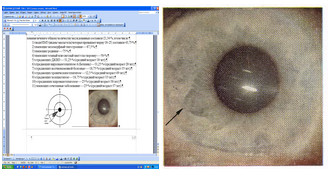Gomel, Belarus
Introduction
Back in the ancient world, was spotted relationship of various human diseases, with its constitution. Currently, under the constitution understood as a set of functional and morphological characteristics of the organism, formed on the basis of inherited and acquired properties that determine the identity of the reaction of the organism to external and internal stimuli. An important component of a real person’s constitution is the constitution of the somatic or body features. Somatotype – body type – defined on the basis of anthropometric measurements (somatotipirovaniya) genotypically driven, constitutional type, characterized by the feature level and metabolism (primary development of muscle, fat or bone), susceptibility to certain diseases, as well as psycho-physiological differences. Identifying patterns of correlation between somatotype human predisposition to disease is a serious tool in the differential diagnosis in the early stages. Especially for diseases of the liver, which responds well to treatment for preventive measures (diet, healthy life style, etc.)
The purpose of the study
Identify patterns of correlation between somatotype human predisposition to diseases of the liver.
Materials and methods
The study was conducted by surveying employees and patients RSPC “otorhinolaryngology” (Minsk) of 25 persons of which were found 8 people with liver disease, and students of Gomel State Medical University (Gomel), respectively, 50 and 8.
As constitutional somatic symptoms were selected: age, body weight, body proportions (dolihomorfny, brachymorphic, mesomorphic), muscle development, the development of body fat, the presence of freckles, the color of the iris eye.
As specific liver diseases have been chosen: biliary dyskinesia (DZHVP), acute hepatitis A (Botkin), cholelithiasis, chronic hepatitis, cholecystitis, steatosis.
Results of the study
The study found that the number of people with liver disease to the total number studied was 21.34%, including:
1) people a BMI (body mass index) greater than the rate of 18-25, was 43.75%;
2) having a mesomorphic type of structure – 87.5%;
3) having a mole – 75%;
4) having a dark or light eye color evenly – 50%;
5) suffering DZHVP – 31.25% (mean age 18 years);
6) suffering from viral hepatitis A (Botkin) – 31.25% (mean age 20 years);
7) suffering from gallstone disease – 18.75% (mean age 35 years);
8) chronic hepatitis B – 12.5% (mean age 49 years);
9) suffering from cholecystitis – 18.75% (mean age 33 years);
10) suffering from fatty hepatosis – 25% (mean age 38 years);
11) with co-morbidity – 25% (mean age 37 years).

As an express method of confirming the diagnosis, was used iridology (the definition of human diseases iris), the extended gap iris of the right eye and bulging Autonomous ring in the projection area of the liver – for 8 hours.
The result of liver disease were able to confirm in 25% of affected patients. It is especially true for diseases such as cholecystitis and cholelithiasis. It should be noted that this characteristic feature is usually only able to identify patients older than 30 years when the disease becomes chronic.
As follows from the results of the study, the following conclusions:
1. Eye color is not a predisposing factor for liver disease.
2. The presence of multiple moles suggests possible liver diseases.
3. Elevated BMI index can be considered for the prevention of diseases of the liver and therefore recommend the patients to lead an active lifestyle and a diet.
4. Acute diseases, in the absence of adequate attention from the patient to them, become chronic, and often to several combined.
5. Iridodiagnostics methods can be used for differential diagnosis of liver disease in people over 30 years, primarily to detect disease at an early stage, when they have an acute form.
REFERENCES
1. Diseases of the liver and biliary tract / ed. Acad. Frame profiles. VT Ivashkina. – 2nd ed. – M.: M-News, 2005. – S. 205-516.
2. Iridology / ES Velhover [et al.] – M.: Medicine, 1988. – 240.
3. Okorokov, AN Internal Medicine: Pract. Tutorial: 3 t / AN ham. – T. 1. – Minsk: Your. wk., 1995. – 522 p.
4. Kozlowski, IV Diseases of the digestive system: diagnosis, differents. diagnosis and treatment / IV Kozlovsky. – Minsk, Belarus, 1989. – 240.
5. Velhover, ES Clinical iridology: monograph / ES Velhover. – M.: Orbit, 1992. – 432 p.

Leave A Comment